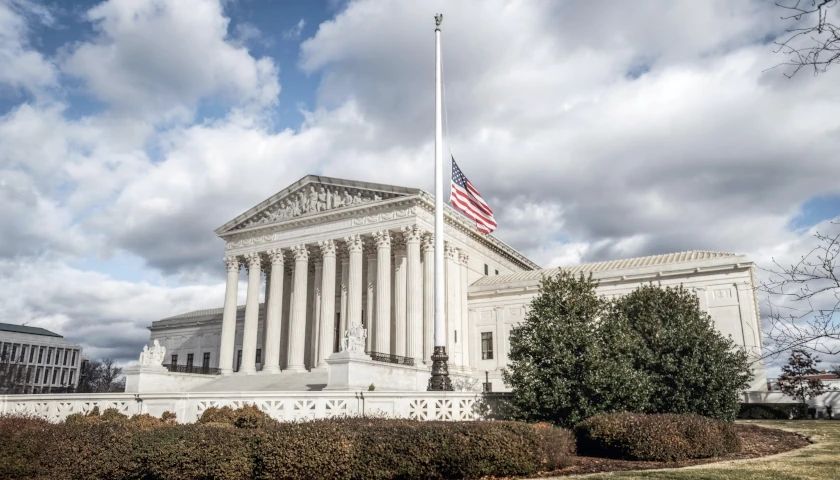by Philip Hamburger
Last week, in Murthy v. Missouri, the Supreme Court hammered home the distressing conclusion that, under the court’s doctrines, the First Amendment is, for all practical purposes, unenforceable against large-scale government censorship. The decision is a strong contender to be the worst speech decision in the court’s history.
(I must confess a personal interest in all of this: My civil rights organization, the New Civil Liberties Alliance, represented individual plaintiffs in Murthy.)
All along, there were some risks. As I pointed out in an article called “Courting Censorship,” Supreme Court doctrine has permitted and thereby invited the federal government to orchestrate massive censorship through the social media platforms. The Murthy case, unfortunately, confirms the perils of the court’s doctrines.
One danger was that the court would try to weasel out of reaching a substantive decision. Months before Murthy was argued, there was reason to fear that the court would try to duck the speech issue by disposing of the case on standing.
Indeed, in its opinion, the court denied that that the plaintiffs had standing by inventing what Justice Alito calls “a new and heightened standard” of traceability – a standard so onerous that, if the court adheres to it in other cases, almost no one will be able to sue. It is sufficiently unrealistic that the court won’t stick to it in future cases.
The “evidence was more than sufficient to establish” at least one plaintiff’s “standing to sue,” and consequently, as Alito’s dissent pointed out, “we are obligated to tackle the free speech issue.” Regrettably, the court, however, again in Alito’s words, “shirks that duty and thus permits … this case to stand as an attractive model for future officials who want to control what the people say, hear, and think.” The case gives a greenlight for the government to engage in further censorship.
A second problem was doctrinal. The Supreme Court has developed doctrine that encourages government to think it “can censor Americans through private entities as long as it is not too coercive.” Accordingly, with painful predictability, the oral argument in Murthy focused on whether or not there had been government coercion.
The implications were not lost on the government. Although it had slowed down its censorship machine during litigation, it revved it up after the court’s hearing emphasized coercion. As put by Matt Taibbi, “the FBI and the Department of Homeland Security reportedly resumed contact with Internet platforms after oral arguments in this case in March led them to expect a favorable ruling.”
The First Amendment, however, says nothing about coercion. On the contrary, it distinguishes between “abridging” the freedom of speech and “prohibiting” the free exercise of religion. As I have explained in great detail, the amendment thereby makes clear that the Constitution’s standard for a speech violation is abridging, that is, reducing, the freedom of speech, not coercion. A mere reduction of the freedom violates the First Amendment.
The court in Murthy, however, didn’t recognize the significance of the word “abridging.” This matters in part for the standing question. It’s much more difficult to show that the plaintiffs’ injuries are traceable to government coercion than to show that they are traceable to government abridging of the freedom of speech. More substantively, if the court had recognized the First Amendment’s word “abridging,” it would have clarified to the government that it can’t use evasions to get away with censorship.
Other doctrinal disasters included the court’s casual indifference to listeners’ or readers’ rights – the right of speakers to hear the speech of others. The court treated such rights as if they were independent of the rights of speakers and therefore concluded that they would broadly invite everyone to sue the government.
But listeners’ rights are most clearly based in the First Amendment when they are understood as the right of speakers to hear the speech of others, as this is essential for speakers to formulate and refine their own speech. The right of speakers to hear what others say is, therefore, the core of listeners’ rights. From this modest understanding of listeners’ rights, the plaintiffs’ rights as listeners should have been understood as part of their rights as speakers – an analysis that would’ve avoided hyperbolical judicial fears of permitting everyone to sue.
The court’s concern that a recognition of listeners’ rights would open up the courts to too many claimants is especially disturbing when the government has censored millions upon millions of posts with the primary goal of suppressing what the American people can hear or read. When the most massive censorship in American history prevents Americans from learning often true opinion on matters of crucial public interest, it should be no surprise that there are many claimants. The court’s disgraceful reasoning suggests that when the government censors a vast number of Americans, we lose our right of redress.
The greatest danger comes from the court’s tolerance of the sub-administrative power that the government uses to corral private parties into becoming instruments of control. Administrative regulation ideally runs through notice-and-comment rulemaking. In contrast, sub-administrative regulation works through informal persuasion, including subtle threats, regulatory hassle, and illicit inducements. By such means, the government can get the private platforms to carry out government orchestrated censorship of their users.
The federal government once had no such sub-administrative power, and it therefore had little control over speech. It could punish speakers only through criminal prosecutions – that is, by going to court and showing that the defendants’ speech violated the criminal law. Now, however, federal officials can subtly get the platforms to suppress speech – often covertly, so an individual won’t even know he is being suppressed. Thus, whereas the government traditionally could only punish the individual, it now can make his speech disappear.
Even worse, the court’s tolerance of this sub-administrative privatization of censorship reverses the burden of proof. Government once had to prove to a judge and jury that a speaker’s words were illegal. Now, instead, the speaker must prove that the government censored him.
What’s more, there’s no effective remedy. The court’s qualified immunity doctrine makes it nearly impossible for censored individuals to get damages for past censorship. And the obstacles to getting an injunction mean that it’s nearly impossible to stop future censorship. For example, the government can claim, as it did in Murthy, that it’s no longer censoring the affected individual. Then, poof! The possibility of an injunction disappears. Moreover, because of the court’s indifference to listeners’ rights – even to the right of speakers to hear the speech of others, an injunction can protect only a handful of individuals; it can’t stop the government’s massive censorship of vast numbers of Americans.
The court thus puts Americans affected by censorship in an unenviable position. It reverses the burden of proof and denies Americans any effective remedy.
So, for multiple reasons, Murthy is probably the worst speech decision in American history. In the face of the most sweeping censorship in American history, the decision fails to recognize either the realities of the censorship or the constitutional barriers to it. In practical terms, the decision invites continuing federal censorship on social media platforms. It thereby nearly guarantees that yet another election cycle will be compromised by government censorship and condemns a hitherto free society to the specter of mental servitude.
– – –
Philip Hamburger teaches at Columbia Law School and is CEO of the New Civil Liberties Alliance.




